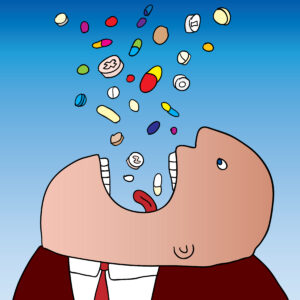
I can read and write as well as anyone. My hearing is fine. I’m a reasonably smart individual. Why then, when my husband came home from hospital after surgery with a prescription for four different tablets and an exercise regime, did it take us two days to figure out how to manage his pain?
Simply put, despite the doctor’s explanation and the big sticker on the outside of the packets, we didn’t understand what each tablet was for, and therefore didn’t understand the impact of timing, or how the tablets would integrate with other medication for an existing long term condition. (6pt font leaflets don’t help, but Google does.)
Not surprisingly, we’re not the only people to struggle with medication management. Patients, by definition, feel unwell, and suffer varying degrees of pain and anxiety. Add the stress levels and mixed emotions associated with illness, to the speedy, lingo-ridden instructions given by medical staff, and it’s almost inevitable that confusion arises.
Health Literacy It turns out, we’re not sufficiently Health Literate. Research bears this out. The European health literacy survey (HLS-EU) states that “health literacy concerns the capacities of people to meet the complex demands of health in modern society”. Research was conducted in eight countries: Austria, Bulgaria, Germany, Greece, Ireland, the Netherlands, Poland and Spain. The total sample was 8,000 people.
Results The HLS-EU-Q defines four levels of health literacy: insufficient, problematic, sufficient and excellent. At least 1 in 10 (12%) respondents showed insufficient health literacy and almost 1 in 2 (47%) had limited (insufficient or problematic) health literacy. Subgroups within the population, defined by financial deprivation, low social status, low education or old age, had higher proportions of people with limited health literacy. On the face of it, Ireland doesn’t fare too badly. When you think about it though, about 40% of people have problematic health literacy. It’s easy to exaggerate the impact of survey results, but this one certainly has the potential to be “a matter of life and death”.
 So, what’s the solution? Some interesting approaches are being taken. The National Adult Literacy Association (NALA), is rolling out Crystal Clear Pharmacy, and Crystal Clear General Practice quality standards. According to NALA, patients who are better informed about their health:
So, what’s the solution? Some interesting approaches are being taken. The National Adult Literacy Association (NALA), is rolling out Crystal Clear Pharmacy, and Crystal Clear General Practice quality standards. According to NALA, patients who are better informed about their health:
- have more effective consultations with their health care provider,
- are better informed about the medicines they are prescribed, and
- are more likely to comply with their medication and as a result have improved health outcomes.
Another approach is to use existing technology to support patients. Very few people are without smart phones, and they have the capacity to host audio-visual patient support tools that remain instantly accessible to the patient. Let’s take a simple example. How about a photo of the medication with a voice over explaining what it’s for and how to take it?
“Anonymex is the pink tablet in the orange box. It helps your stomach cope better with the other medications that you’re taking. Take this once a day, one hour before your main meal.”
Add a reminder feature, and your now have a medication management facility that stays with the patient when they go home.
It’s good to place the patient at the centre of their own care. That means supporting them to ask questions, express their fears, look for alternatives, and provide the information they need in a way that’s clear, and easily accessible. Mobile technology can play a substantial role in making this happen. Giving the patient the information in a format they understand supports better adherence and outcomes. Achieving that would be a good news story!
16th February 2016
#HealthLiteracy #Patientsupporttools #Mobilehealthtechnology #Digitalhealth